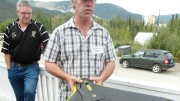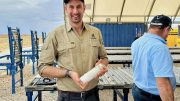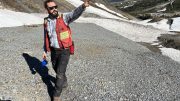When and if the final water licence and road permits are issued, Canadian Zinc (CZN-T) will at last be in a position to get its Prairie Creek zinc-lead-silver project here in the southwest corner of the Northwest Territories into production (for part I of this site visit, see T.N.M., Sept. 24–30/12).
The company has $12 million in cash, and estimates that it will need $200 million to build a mine that would generate a net present value of $253 million, using an 8% discount rate. The internal rate of return is an estimated 40.4%.
These numbers come out of a prefeasibility study released by SNC Lavalin this year, and were generated using zinc and lead prices of US$1.20 per lb., and a silver price of US$28 per oz. for the first two years. It used longer-term prices of US$1 per lb. for lead and zinc, and US$26 per oz. silver.
The study envisions a mine that would produce 60,000 tonnes of zinc concentrate and 60,000 tonnes of lead concentrate, for 76 million lb. zinc, 90 million lb. lead and 2.2 million oz. silver per year.
Of the construction costs, roughly $80 million will go towards improving the mill, with the big ticket expenses residing in new diesel generators, a dense-media-separation (DMS) plant and building a paste-fill plant to handle tailings. These items are expected to account for $80 million of $160 million in capital expenditures, leaving $30 million for contingencies.
It’s a bargain by today’s standards, as far as Taylor is concerned.
“One of the reasons we’re here is because of the mill that is already standing,” he says. “It would cost a quarter of a billion to build this facility from scratch.”
After 30 years, the mill is in surprisingly good condition. Once it is refurbished, it will have a 1,700-tonne-per-day crushing capacity, although the plan is to mine 1,300 tonnes per day, and mill 1,000 tonnes per day.
To run the mill Canadian Zinc will need 5 megawatts of power, which will come from new Caterpillar diesel generators. The 1.5-megawatt units cost $20 million, but use 30% less fuel than the rusting hulks now housed in the mill. Heat from the new generators will also help heat the camp.
Another new addition to the facility will be the DMS plant, which will be part of the crushing circuit and separate light from heavy material, allowing the company to upgrade feed without expanding the mill.
Taylor says the DMS plant will help relieve stress on dilution from underground operations by removing all limestone and dolostone at an early stage — acting as a kind of pre-concentrator of ore, before it goes through the rest of the circuit. Some of the waste rock from the DMS plant will be carried by conveyor belt to mix with tailings and aggregate at the paste-fill plant.
The paste-fill plant is a major component of the mine’s environmental protection engineering. Rather than deal with any risks of having a tailings pond in a river valley, all tailings from underground will be processed in the plant, and put back underground as paste fill for areas that have been mined.
Forty-seven percent of the mined rock will go back into the mine as paste backfill, 27% will be stored as harmless waste rock — with no acid rock drainage issues — and the remaining 26% will make its way into the concentrates.
These concentrates will contain silver and copper, with the lead concentrate holding silver at a ratio of 7 to 3 in favour of lead. Copper will appear in both the lead and zinc concentrates at a 1-to-1 ratio.
Taylor says it is also possible to produce a copper concentrate on its own. The idea was considered back when the Hunt brothers ran the show, but the process being considered at that time involved using cyanide. Cyanide is off the table, given today’s heightened environmental sensitivities, but Taylor says that a copper concentrate could be made without using cyanide. The economics of this process are being evaluated.
The ore, however, has a high mercury content, especially in the zinc concentrate. Taylor says the company has already reached out to smelter operators, who are confident that the mercury content is workable.
Feeding the concentrate production will be a deposit with measured and indicated resources of 5.43 million tonnes grading 10.8% zinc and 10.2% lead, with 160 grams per tonne silver and inferred resources of 6.24 million tonnes grading 14.5% zinc and 11.5% lead, with 229 grams silver per tonne.
Of the measured and indicated material, 5.2 million tonnes are in the proven and probable reserve category, with an average grade of 9.4% zinc, 9.5% lead and 151 grams silver.
But like many underground deposits, the rich mineralization trends to greater depths, and a producing mine at Prairie Creek could prove-up new reserves as it goes forward.
The preliminary feasibility study completed in June outlined a mine with an initial 11-year mine life, ignoring inferred resources. To give a sense of just how much mineralization is present, the current global resource runs 2.1 km down into the base of the mountain, with more than half of that area remaining in the inferred category. Exploration drills tested a further 1.8 km downdip, and hit high grades, with a highlight intercept of 3.4 metres grading 11% zinc and 5% lead.
The deposit is composed of a richly mineralized vein that is part of the north-trending Prairie Creek fault structure, which runs over 10 km on the property. Within that structure there are 12 separate sulphide vein occurrences, but the current resource focuses on Zone 3.
Walking down the adit and into the mine, the mineralized vein of Zone 3 is readily visible. It cuts through the Whittaker formation (below the cut), and the Road River formation (above the cut).
The two structures make finding targets for future exploration a somewhat simple task. The Rico showing offers the most exploration-upside potential, and even though it is roughly 6 km from the mine site, it too is connected to the Whittaker and Road River formations.
The Rico showing is made up of high-grade boulders that were discovered during road construction. Assays returned 1.1 metres grading 35% lead, 18% zinc and 242 grams silver. Taylor opines that the high-grade boulders likely came from the same Road River and Upper Whittaker formations that host the known deposit, because the Cadillac formation — which overlies Road River and upper Whittaker — is brittle, and would have allowed mineralization to pass through. If this is the case, Zone 3 could extend another 4 km.
As for how much capital should go into continued exploration, considering how much ore has already been outlined, Taylor is ambivalent.
“We can do it or not,” he says. “The region likes to see activity at the site, and without exploration, there wouldn’t be much activity.”
The statement points to how much the company values community relations, and how well it has done on that front.
The two impact-benefit agreements signed in 2011 cover the community of Nahanni Butte —which is the closest community to the mine, at 90 km southeast — and Fort Simpson, 150 km west.
Signing the deals was a testament to the strong community relations team that Canadian Zinc has assembled. Taylor gives much of the credit to Wilbert Antoine, an elder and member of the Liidlii Kue First Nation, who has 40 years of experience in the mining industry. Antoine is the company’s manager of northern development.
Coinciding with the improved community relations is Bob McLeod’s tenure as premier of the Northwest Territories. McLeod, who was elected in 2011, is considered one of the most dynamic premiers in terms of supporting northern development.
Such an improved business environment makes Taylor optimistic. “There are
more challenges behind us than ahead of us, now,” he says.
It’s been a tough road for the company to get where it is today. The usual technical challenges of outlining a deposit and planning a mine have been compounded by the project’s location, and being in a remote area makes the Prairie Creek project especially susceptible to ill-formed opinions from the public. If an average citizen in Calgary or Halifax reads that a company plans to build a mine near a National Park, he or she would be concerned.
But that kind of knee-jerk concern fails to consider that a facility has already been standing for 30 years, and that engineering has advanced to a level where a facility can be built that doesn’t degrade the surrounding environment.
With time and education, perceptions about building a mine near a treasured park are changing. Naysayers play to Canadians’ pride in pristine landscapes, but others argue that pride can also be drawn from Canadians’ mining expertise and environmental sensitivity that allows for the building of a mine that can contribute to the Far North’s economy without wrecking the surrounding land — a fine balance between engineering, economics and environmental stewardship not found just anywhere in the world.






Be the first to comment on "Unfinished business at Prairie Creek, part II"